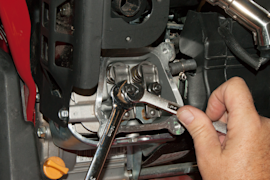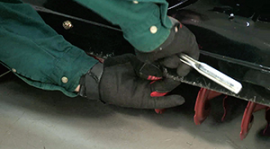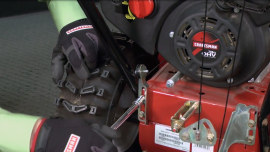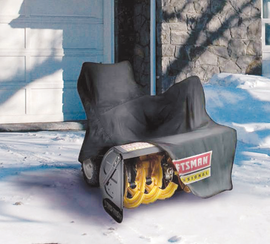- Kenmore refrigerator water filters
- Whirlpool refrigerator water filters
- Samsung refrigerator water filters
- GE refrigerator water filters
- LG refrigerator water filters
- Frigidaire refrigerator water filters
- KitchenAid refrigerator water filters
- Maytag refrigerator water filters
- Kenmore Elite refrigerator water filters
- Estate refrigerator water filters
- GE Profile refrigerator water filters
- Amana refrigerator water filters
- Bosch refrigerator water filters
- Dacor refrigerator water filters
- Electrolux refrigerator water filters
How to engage the snowblower drive


This video shows how to operate the drive controls on a common snowblower. Seeing how to operate the controls on video can be more helpful than reading about it in the manual.
If the controls on your snowblower differ from the ones shown in the video, follow the instructions in the owner’s manual to operate the snowblower.
Engaging the snowblower drive system
Once you have the snowblower engine started, follow these steps to drive the snowblower:
Move the throttle control to the fast or “rabbit” position.
Position the shift lever to the desired drive position. Use slower forward or reverse speed settings when you’re unfamiliar with driving the snowblower.
Squeeze the drive control lever against the handle to spin the snowblower wheels.
Steer the snowblower in the desired direction. If your snowblower has power steering, pull the right trigger control to turn the snowblower right or pull the left trigger control to turn the snowblower left.
Release the drive control lever to stop the snowblower.
When throwing snow, select a drive speed appropriate for the conditions of the area that you’re clearing and a pace that you’re comfortable with.
Never reposition the shift lever to change speeds or direction of travel without first releasing the drive control lever and bringing the snow thrower to a complete stop. Doing so will cause premature drive system wear.

Adjusting the snow thrower shift cable
When you can’t properly control snowblower speed using the shift lever, you likely need to adjust shift cable tension.
Park the snow thrower on a level surface with the engine shut off.
Place the shift lever in the fastest forward speed position.
Loosen the hex nut on the shift cable index bracket.
Pivot the bracket downward to remove slack in the shift cable. If you’re not able to remove slack from the cable by moving the bracket downward, disconnect the shift cable from the index bracket and reconnect it in a lower hole so that you can remove slack from the shift cable.
While holding the shift cable tight, tighten the hex nut.
View our How to Adjust a Snowblower Shift Cable Video to see how to complete the adjustment.
Test the snowblower drive performance and continue to adjust the cable until the snowblower drives properly at all selected speeds.
Perform snowblower maintenance
Maintaining your snowblower or snowthrower will help keep it in top condition and lasting longer.
Major steps of snowblower and snow thrower maintenance include:
Performing an engine tune-up.
Lubricating all moving parts.
Checking and replacing belts.
Completing these maintenance steps can be overwhelming for some people. Instead of performing the maintenance yourself, you can have a Sears Technician do it by scheduling Snowblower Maintenance & Cleaning Service.
In addition to professionally performing the above maintenance tasks, the Sears Technician will complete these important tasks:
Check ignition system, carburetor, throttle, and choke controls.
Check the recoil starter and electric starter if so equipped.
Test the overall operation of the snowblower.
Ensure that all safety features are fully operational.
Having your snowblower professionally serviced every year will also help prevent breakdowns during the snow clearing season. Trust Sears to help you keep your snowblower or snow thrower working properly all season long.
Symptoms for gas snowblowers
Choose a symptom to see related snowblower repairs.
Things to do: replace the spark plug, change the oil, rebuild the carburetor, adjust valve lash, adjust or replace the b…
Main causes: clogged chute, damaged auger blades, broken shear pins, worn auger belt, damaged gear case, engine problems…
Main causes: dirty carburetor, stale fuel…
Main causes: punctured tire, damaged rim…
Main causes: dirty carburetor, clogged fuel filter, dirty spark plug, incorrect valve lash, leaky engine gaskets…
Main causes: stale gas, clogged carburetor, clogged or broken fuel line, dirty spark plug, bad rewind starter, incorrect…
Main causes: loose drive clutch cable, damaged drive clutch cable, worn friction disc, scraper blade scraping the ground…
Main causes: snow build-up in chute, chute drive mechanism failure, bad chute control assembly…
Main causes: clogged chute, snow build-up in auger housing, broken auger shear pins, auger drive belt needs adjustment, …
Repair guides for gas snowblowers
These step-by-step repair guides will help you safely fix what’s broken on your snowblower.

How to adjust snowblower engine valve lash
Adjust the engine valve lash on your snowblower to keep the engine starting and running smoothly.…
Repair difficulty
Time required
15 minutes or less

How to adjust snowblower skid shoes
To prevent snowblower auger and shave plate damage, adjust the skid shoes regularly to keep the shave plate ¼-inch high.…
Repair difficulty
Time required
15 minutes or less

How to replace a snowblower shave plate
Follow the 7 easy steps in this repair guide/video to replace a worn out shave plate on your snowblower.…
Repair difficulty
Time required
15 minutes or less
Articles and videos for gas snowblowers
Use the advice and tips in these articles and videos to get the most out of your snowblower.

Find out how to clear chute obstructions, replace shear pins and adjust or replace your auger engagement cable if your s…

Find easy DIY tips to fix your snowblower when it won't start…

Protect your snowblower's engine and body by preparing it for after-season storage.…